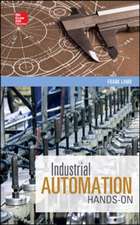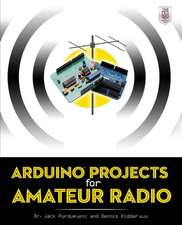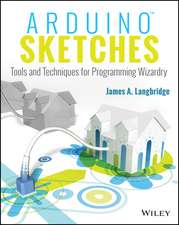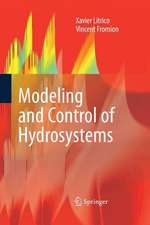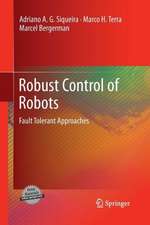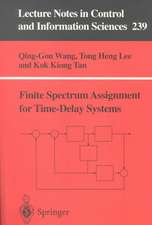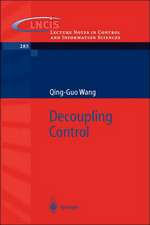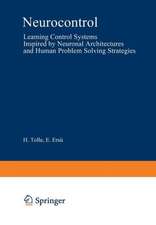Advances in PID Control: Advances in Industrial Control
Autor Kok K. Tan Cu Tore Hägglund Autor Qing-Guo Wang, Chang C. Hangen Limba Engleză Paperback – 16 sep 2011
Evolution and components of PID controllers
Classical and Modern PID controller design
Automatic Tuning
Multi-loop Control
Practical issues concerned with PID control
The book is intended to be useful to a wide spectrum of readers interested in PID control ranging from practising technicians and engineers to graduate and undergraduate students.
Din seria Advances in Industrial Control
- 15%
 Preț: 643.34 lei
Preț: 643.34 lei - 23%
 Preț: 582.63 lei
Preț: 582.63 lei - 18%
 Preț: 783.98 lei
Preț: 783.98 lei - 18%
 Preț: 947.35 lei
Preț: 947.35 lei - 20%
 Preț: 568.24 lei
Preț: 568.24 lei - 15%
 Preț: 643.16 lei
Preț: 643.16 lei - 18%
 Preț: 899.21 lei
Preț: 899.21 lei - 18%
 Preț: 891.33 lei
Preț: 891.33 lei - 18%
 Preț: 740.57 lei
Preț: 740.57 lei - 18%
 Preț: 961.23 lei
Preț: 961.23 lei - 18%
 Preț: 955.08 lei
Preț: 955.08 lei - 15%
 Preț: 645.28 lei
Preț: 645.28 lei - 15%
 Preț: 638.43 lei
Preț: 638.43 lei - 18%
 Preț: 901.11 lei
Preț: 901.11 lei - 18%
 Preț: 1410.94 lei
Preț: 1410.94 lei - 18%
 Preț: 728.91 lei
Preț: 728.91 lei - 20%
 Preț: 1003.77 lei
Preț: 1003.77 lei - 18%
 Preț: 947.35 lei
Preț: 947.35 lei - 15%
 Preț: 643.34 lei
Preț: 643.34 lei - 15%
 Preț: 654.30 lei
Preț: 654.30 lei - 18%
 Preț: 950.52 lei
Preț: 950.52 lei - 15%
 Preț: 644.30 lei
Preț: 644.30 lei - 18%
 Preț: 1393.09 lei
Preț: 1393.09 lei - 18%
 Preț: 950.21 lei
Preț: 950.21 lei - 18%
 Preț: 949.90 lei
Preț: 949.90 lei - 18%
 Preț: 949.42 lei
Preț: 949.42 lei - 18%
 Preț: 950.52 lei
Preț: 950.52 lei - 18%
 Preț: 1113.71 lei
Preț: 1113.71 lei - 15%
 Preț: 650.04 lei
Preț: 650.04 lei - 15%
 Preț: 644.95 lei
Preț: 644.95 lei - 18%
 Preț: 950.33 lei
Preț: 950.33 lei - 18%
 Preț: 948.61 lei
Preț: 948.61 lei - 18%
 Preț: 1112.60 lei
Preț: 1112.60 lei - 15%
 Preț: 644.63 lei
Preț: 644.63 lei - 18%
 Preț: 953.20 lei
Preț: 953.20 lei - 18%
 Preț: 945.62 lei
Preț: 945.62 lei - 15%
 Preț: 640.88 lei
Preț: 640.88 lei - 15%
 Preț: 640.88 lei
Preț: 640.88 lei - 20%
 Preț: 650.92 lei
Preț: 650.92 lei - 18%
 Preț: 1112.60 lei
Preț: 1112.60 lei - 20%
 Preț: 998.36 lei
Preț: 998.36 lei - 15%
 Preț: 643.34 lei
Preț: 643.34 lei - 18%
 Preț: 948.92 lei
Preț: 948.92 lei - 18%
 Preț: 1381.43 lei
Preț: 1381.43 lei - 15%
 Preț: 651.51 lei
Preț: 651.51 lei - 15%
 Preț: 647.08 lei
Preț: 647.08 lei - 20%
 Preț: 563.66 lei
Preț: 563.66 lei - 18%
 Preț: 992.64 lei
Preț: 992.64 lei - 18%
 Preț: 1225.79 lei
Preț: 1225.79 lei
Preț: 640.06 lei
Preț vechi: 753.01 lei
-15% Nou
Puncte Express: 960
Preț estimativ în valută:
122.47€ • 127.87$ • 101.36£
122.47€ • 127.87$ • 101.36£
Carte tipărită la comandă
Livrare economică 04-18 aprilie
Preluare comenzi: 021 569.72.76
Specificații
ISBN-13: 9781447112198
ISBN-10: 1447112199
Pagini: 288
Ilustrații: XVII, 264 p.
Dimensiuni: 155 x 235 x 15 mm
Greutate: 0.41 kg
Ediția:Softcover reprint of the original 1st ed. 1999
Editura: SPRINGER LONDON
Colecția Springer
Seria Advances in Industrial Control
Locul publicării:London, United Kingdom
ISBN-10: 1447112199
Pagini: 288
Ilustrații: XVII, 264 p.
Dimensiuni: 155 x 235 x 15 mm
Greutate: 0.41 kg
Ediția:Softcover reprint of the original 1st ed. 1999
Editura: SPRINGER LONDON
Colecția Springer
Seria Advances in Industrial Control
Locul publicării:London, United Kingdom
Public țintă
Professional/practitionerCuprins
1. Introduction.- 1.1 Evolution of the PID Controller.- 1.2 Components of the PID Controller.- 1.3 Choice of Controller Type.- 1.4 Nomenclature of the PID Controller.- 1.5 Structures of the PID Controller.- 2. Classical Designs.- 2.1 Introduction.- 2.2 Design Objectives - Speed Versus Stability.- 2.3 Trial and Error Method.- 2.4 The Ziegler-Nichols Methods.- 2.5 The Stability Limit Method.- 2.6 The Cohen-Coon Method.- 2.7 The Tyreus-Luyben Method.- 3. Modern Designs.- 3.1 Introduction.- 3.2 Constraints of Classical PID Control.- 3.3 Pole Placement Design.- 3.4 Dominant Pole Placement.- 3.5 Gain and Phase Margin Design I: PI Controller.- 3.6 Gain and Phase Margin Design II: PID Controller.- 3.7 Linear Quadratic Control Design.- 3.8 Composite PI-Adaptive Control Design.- 4. Automatic Tuning.- 4.1 Introduction.- 4.2 Step Response Approach.- 4.3 Relay Feedback Approach.- 4.4 On-line Relay Tuning.- 4.5 FFT on Relay Transients.- 4.6 Frequency Response - Transfer Function Conversion.- 4.7 Continuous Self-Tuning of PID Control.- 5. Multi-loop Control.- 5.1 Introduction.- 5.2 The Modified Ziegler-Nichols Method.- 5.3 Review of the BLT (Biggest Log-Modulus Tuning).- 5.4 Modified Ziegler-Nichols Method for Multi-Loop Processes.- 5.5 Derivation of the Design Equations.- 5.6 Simulation study.- 5.7 Extension to Cross-coupled Controllers.- 6. Practical Issues.- 6.1 Introduction.- 6.2 Non-linearities.- 6.3 Disturbances.- 6.4 Operational Aspects.- 6.5 Digital PID Implementation.- A. Industrial Controllers.- A.l ABB COMMANDER 351.- A.2 Elsag Bailey Protonic 500/550.- A.3 Foxboro 718PL/PR.- A.4 Honeywell UDC3300.- References.
Caracteristici
PID control has a long history and widespread use in engineering The subject is covered comprehensively and in depth from its classical to its modern aspects

